Evaluation and Analysis of Development Status of Yellow River Beach Area Based on Multi-Source Data and Coordination Degree Model
Abstract
:1. Introduction
2. Study Area and Data
2.1. Study Area
2.2. Study Data
3. Calculation of Indicators
3.1. Indicator Calculation Based on Remote Sensing Images
Remote Sensing Ecological Index
- (1)
- Normalized Difference Vegetation Index (NDVI)
- (2)
- Wetness Index (WET)
- (3)
- Normalized Difference Built-up and Soil Index (NDBSI)
- (4)
- Land Surface Temperature Index (LST)
- (5)
- Principal Component Analysis (PCA)
3.2. Indicator Calculation Based on Geospatial Data
3.2.1. Flood Risk Intensity (FRI)
3.2.2. Accessibility Index (AI)
3.2.3. Biological Abundance Index (BAI)
4. Establishment of Index System
- (1)
- The ecological environment quality subsystem considers the two factors of ecological protection and environmental monitoring. According to the characteristics of the Yellow River beach area, four indexes, namely vegetation coverage, flood risk intensity, CO2 emission and beach area, were selected to measure the ecological environment protection factor, and two indexes, namely the biological abundance index and biological environment condition index, were selected to measure the ecological environment monitoring factor.
- (2)
- The economic development level subsystem considered the economic foundation and agricultural development of the beach area, which were measured by three indicators, namely GDP, per capital disposable income, and grain output.
- (3)
- The social livelihood security subsystem considered the population characteristics, public services, and life and education quality of the study area. The population characteristics were measured by the regional population density; the public services were measured according to their accessibility; the quality of life and education were measured by the employment rate, Engel coefficient, and education level.
- (4)
- The flood control construction subsystem considers the flood control degree and infrastructure construction. The degree of flood control was measured using four aspects: the construction rates of rivers and dams, the resettlement rate, the improvement rates of old village platforms, and the rates of building nearby village platforms. The construction of the infrastructure was measured by the construction rate of evacuation roads.
5. Methods
5.1. Weight Allocation
- (1)
- CRITIC method
- (2)
- Entropy method
5.2. Evaluation Models
- (1)
- The fuzzy membership method was used to quantify the single index [41]. This method eliminates the influence of different dimensions and the positive and negative types between the indicators in the evaluation. After processing each indicator, all indicators were uniformly mapped to the [0, 1] interval. According to the relationships between the indicators and the development level, the development level was divided into positive indicators and reverse indicators. The calculation formulae are shown in Equations (23) and (24). The index function was divided into five sections, with each index having five characteristic values: the worst value, poor value, pass value, better value, and optimal value. The corresponding harmony values were 0, 0.3, 0.6, 0.8, and 1. The single index coordination degree (harmony) calculation formula is:where is the quantitative value of the ith indicator; , , , and are the value, the worst value, the worse value, the passing value, the better value and the best value of the ith indicator, respectively.
- (2)
- The criterion layer contained a number of indicators that were able to reflect the degree of coordination between ecological protection and high-quality development in the Yellow River beach area. In order to comprehensively consider the impact of the indicators on the development level of the Yellow River beach area, based on the calculation of the single-index harmony degree, the weighted summation was used to calculate the harmony degrees of the four subsystems. The specific formula is as follows:
- (3)
- The harmonious development levels of the four subsystems, namely the ecological environment quality, economic development level, social livelihood security, and flood control construction subsystems, were quantitatively studied using Formula (26).
- (4)
- By combining the “multi-criteria integrated calculation” model with the coordination coupling model, an overall coordination degree model of the ecological protection and high-quality development system of the Yellow River beach area was constructed. The specific formula is as follows:where denotes the value of each criterion level; denotes the weight of each indicator; EESF is the level of harmonious development; D is the degree of overall coupling and coordination; is the development index of high-quality development; is the development index of ecological protection; is the weight of the four criterion layers. The four criterion layers constructed in this paper had the same degree of importance, so their weights were 0.25.
5.3. Spatial Autocorrelation Model
5.4. Global Sensitivity and Uncertainty Analyses
6. Results
6.1. Results of Indicators Based on Remote Sensing Images
6.2. Results of Indicators Based on Geospatial Data
6.2.1. Results of FRI
6.2.2. Results of AI
6.2.3. Results of BAI
6.3. Changes in the Harmonious Development Level of Ecological Protection and High-Quality Development Systems in the Yellow River Beach Area
- (1)
- Changes in the development index of each subsystem at the city scale
- (2)
- Changes in the level of harmonious development of the overall system at the urban scale
6.4. Spatial-Temporal Evolution Characteristics of Coupling and Coordinated Development of Ecological Protection and High-Quality Development System in Yellow River Beach Area
6.4.1. Analysis of Time Variation Characteristics
6.4.2. Analysis of Spatial Distribution Characteristics
6.4.3. Analysis of Spatial Autocorrelation Results
- (1)
- Analysis of global spatial autocorrelation results
- (2)
- Analysis of local spatial autocorrelation results
6.4.4. Global Sensitivity and Uncertainty Analysis Results
- (1)
- Global sensitivity analysis results
- (2)
- Uncertainty analysis results
7. Discussion and Conclusions
- (1)
- In the past 10 years, the coordinated development level of the Yellow River beach area in Shandong Province has generally shown an upward trend, from 0.344 in 2009 to 0.580 in 2019.
- (2)
- Spatial autocorrelation analysis showed that the spatial distribution of the coordinated development level of the Yellow River beach area had a significant autocorrelation and a certain degree of increase in ten years; the ‘not significant’ type was dominant, and only one county showed ‘H-L’ clustering, indicating that the spatial heterogeneity of the coordinated development level of the Yellow River beach area was small.
- (3)
- Global sensitivity and uncertainty analysis showed that 2009 and 2019 were the most sensitive to grain yield (X2), followed by beach GDP (X1) and embankment protection rate (X9). The coefficients of variation were 9.58% and 7.91%, respectively, which belonged to weak variation and low uncertainty.
Author Contributions
Funding
Institutional Review Board Statement
Informed Consent Statement
Data Availability Statement
Acknowledgments
Conflicts of Interest
References
- Guo, H.; Ren, B. Spatial governance of high-quality development in the Yellow River Basin: Mechanism interpretation and realistic strategy. Reform 2020, 4, 74–85. [Google Scholar]
- Wang, J.; Liu, J.; Song, Z.; Huang, L.; Fang, Y.; Li, Z. Ecological protection and land space utilization strategies for high-quality development in the Yellow River Basin. J. Nat. Resour. 2022, 37, 2930–2945. [Google Scholar]
- Wang, T.; Xu, Z.; Kong, K.; Zhao, Z.; Zhang, L.; Qi, Z. Countermeasures for sustainable development of Yellow River beach area in Shandong. China Water Conserv. 2016, 10, 15–17. [Google Scholar]
- The theoretical study group of the Ministry of Water Resources studied and discussed the important speech of General Secretary Xi Jinping at the symposium on promoting the ecological protection and high-quality development of the Yellow River Basin. China Water Resour. 2021, 21, 5.
- Zuo, Q. Key issues of floodplain management in the lower reaches of the Yellow River and construction of collaborative governance system. Technol. Bull. 2020, 38, 23–32. [Google Scholar]
- Zhang, J. Reconstruction and ecological management of the lower reaches of the Yellow River. People’s Yellow River 2017, 39, 24–27+33. [Google Scholar]
- Tian, Y.; Sun, Y.; Li, Y.; Ma, J. Research on the direction of floodplain management in the lower reaches of the Yellow River in the new period. People’s Yellow River 2019, 41, 16–20+35. [Google Scholar]
- Geng, M.; Yao, X. Discussion on ecological protection and high-quality development of wide channel in the lower Yellow River. Water Conserv. Constr. Manag. 2019, 39, 6–11+84. [Google Scholar]
- Zhang, H.; Li, Z.; An, Z.; Fang, H.; Huang, H.; Dai, W. Trends and progress of research on river channel and beach area governance in the lower reaches of the Yellow River. Yellow River 2016, 38, 1–10+23. [Google Scholar]
- Teng, X.; Wu, Q.; Huang, S. Study on the application of compensation policy in the lower reaches of the Yellow River. People’s Yellow River 2012, 34, 10–11+14. [Google Scholar]
- Li, G. Theory and practice of temporal air conditioning of water and sand in the middle and lower reaches of the Yellow River. J. Hydraul. Eng. 2004, 8, 1–7. [Google Scholar]
- Zhang, X.; He, N. Comprehensive safety evaluation of embankment project in the lower reaches of the Yellow River. J. Hydraul. Eng. 2007, S1, 135–140+154. [Google Scholar]
- Wang, Z.; Xia, J.; Zhou, M.; Deng, S.; Li, T. Modelling hyperconcentrated floods in the Middle Yellow River using an improved river network model. Catena 2020, 190, 104544. [Google Scholar] [CrossRef]
- Song, J.; Hou, C.; Liu, Q.; Wu, X.; Wang, Y.; Yi, Y. Spatial and temporal variations in the plankton community because of water and sediment regulation in the lower reaches of Yellow River. J. Clean. Prod. 2020, 261, 120972. [Google Scholar] [CrossRef]
- Zhang, J.; Liu, S.; Storm, C.; Zhang, R. Ecological governance model and effect evaluation of the lower Yellow River beach area- “Research on ecological regeneration and governance in the lower Yellow River beach area” No.5. People’s Yellow River 2018, 40, 1–4+33. [Google Scholar]
- Yellow River Water Conservancy Commission, Ministry of Water Resources. Expert Forum on Lower Yellow River Management Strategy; Yellow River Water Conservancy Publishing House: Zhengzhou, China, 2004.
- Jiang, E. Research on Flood Detention and Sediment Deposition Function and Floodplain Disaster Reduction Technology in the Wide Beach Area of the Lower Yellow River; Yellow River Water Conservancy Commission Yellow River Water Conservancy Science Research Institute: Kaifeng, China, 2016. [Google Scholar]
- Yue, Y.; Wang, H.; Jiang, E.; Peng, X.; Shi, F. Sustainable development model of natural-economic-social coordination in floodplain. J. Water Resour. 2020, 51, 1131–1137+1148. [Google Scholar]
- Strong, O.; Cui, Y. Research on comprehensive management and high-quality management and protection of the Yellow River beach area. China’s Land Resour. Econ. 2020, 33, 39–43. [Google Scholar]
- Zhao, L.; Han, S.; Xiao, Q.; Wang, T. The effect of water and sediment regulation in the Yellow River and the idea of comprehensive management of downstream beaches in the future. Sediment Res. 2022, 47, 51–56. [Google Scholar]
- Jiang, L.; Bai, L.; Wu, Y. An Analysis of the Coordination of Provincial Economy, Resources and Environment in China—Also on the Coupling Formula of Three Systems and Its Extended Form. Nat. Resour. J. 2017, 32, 788–799. [Google Scholar]
- Han, S.; Tan, G.; Zhao, L.; Fu, X.; Wang, J. Analysis of the change of sediment situation in the Yellow River. Rural. Water Conserv. Hydropower China 2022, 2, 1–5+19. [Google Scholar]
- Wang, Q.; Zhai, L. Analysis on flood control improvement project of old village platform in Yellow River beach area of Shandong Province. Water Conserv. Plan. Des. 2019, 7, 103–105. [Google Scholar]
- Dong, C. Interpreting ‘Relocation Planning of Residents in Yellow River Beach Area of Shandong Province’-New Life of 600,000 People. Qilu Weekly, 1 September 1999. [Google Scholar]
- Wang, L.; Jiao, L.; Lai, F.; Zhang, N. Evaluation of ecological changes in the wetlands of Manas Lake, Xinjiang based on remote sensing ecological index. J. Ecol. 2019, 39, 2963–2972. [Google Scholar]
- Liu, S.; Zhang, F.; Zhao, X.; Huang, J.; Gao, P. Improvement of remote sensing ecological index for oases in arid areas. Surv. Mapp. Sci. 2022, 47, 143–151+203. [Google Scholar]
- He, L.; Du, Q.; Cui, L.; Guan, L.; Guo, S.; Jiang, L. Evaluation of ecological environment quality in Tarim Reclamation Area based on remote sensing ecological index. Hunan J. Ecol. Sci. 2022, 9, 27–33. [Google Scholar]
- Ke, L.; Xu, J.; Wang, N.; Hou, J.; Han, X.; Yin, S. Evaluation of ecological quality changes in coastal wetlands based on remote sensing ecological indices: An example from the northern part of Liaodong Bay. J. Ecol. Environ. 2022, 31, 1417–1424. [Google Scholar]
- Qin, Z.; Li, W.; Xu, B.; Chen, Z.; Liu, J. Estimation of surface specific emissivity in the TM6 band range of terrestrial satellites. Remote Sens. Land Resour. 2004, 3, 28–32+36–41+74. [Google Scholar]
- Zhang, Y.; She, J.; Long, X.; Zhang, M. Spatio-temporal evolution and driving factors of eco-environmental quality based on RSEI in Chang-Zhu-Tan metropolitan circle, central China. Ecol. Indic. 2022, 144, 109436. [Google Scholar] [CrossRef]
- Cheng, P.; Huang, Y. Flood risk assessment of Nanchang City based on AHP-entropy weight method. People’s Yangtze River 2021, 52, 18–25. [Google Scholar]
- Zhou, Y.; Dong, M.; Liu, W.; Li, H. Dynamic risk assessment of flood disaster in Minjiang River Basin based on GIS. People’s Yangtze River 2022, 53, 20–27. [Google Scholar]
- Fan, H.; Lu, Y.; Hu, Y.; Fang, J.; Lv, C.; Xu, C.; Liu, Y. A landslide susceptibility evaluation of highway disasters based on the frequency ratio coupling model. Sustainability 2022, 14, 7740. [Google Scholar] [CrossRef]
- Weiss, D.J.; Nelson, A.; Gibson, H.S.; Temperley, W.; Peedell, S.; Lieber, A.; Hancher, M.; Poyart, E.; Belchior, S.; Fullman, N.; et al. A global map of travel time to cities to assess inequalities in accessibility in 2015. Nature 2018, 553, 333–336. [Google Scholar] [CrossRef] [PubMed]
- Wan, S.; Fan, Z.; Deng, S.; Bian, A. Study on the accessibility of park green space in the main urban area of Zhangzhou based on network analysis. Jiangxi Sci. 2022, 40, 965–970+1040. [Google Scholar]
- Guo, C.; Zhu, Y.; Sun, W.; Song, J. China 1km Bioabundance Index Dataset. J. Glob. Change Data 2017, 1, 60–65+183–188. [Google Scholar]
- Ji, J.; Wang, S.; Zhou, Y. Spatiotemporal Change and Coordinated Development Analysis of “Population-Society-Economy-Resource-Ecology-Environment” in the Jing-Jin-Ji Urban Agglomeration from 2000 to 2015. Sustainability 2021, 13, 4075. [Google Scholar] [CrossRef]
- Wang, Y.; Wang, R.; Jia, Y. Sustainability evaluation of plain rural ecological space based on SDGs-Taking Heishan County, Liaoning Province as an example. Garden 2022, 39, 4–12. [Google Scholar]
- Diakoulaki, D.; Mavrotas, G.; Papayannakis, L. Determining objective weights in multiple criteria problems: The critic method. Comput. Oper. Res. 1995, 22, 763–770. [Google Scholar] [CrossRef]
- Fan, W.; Chen, B.; Li, Q. Evaluation of new development pattern construction in each province-coupling coordination degree model based on improved CRITIC-entropy method combined weight. China Bus. Rev. 2023, 4, 37–41. [Google Scholar]
- Gao, H.; Zhang, H. Study on coordination and quantification of ecological protection and high quality development in the Yellow River Basin. IOP Conf. Ser. Earth Environ. Sci. 2021, 647, 012168. [Google Scholar]
- Zhang, Y.; Qu, J.; Wang, Q.; Li, D. Global autocorrelation analysis of landscape pattern combined with evenness theory and Moran’s I index and generalized G index. Mapp. Bull. 2018, 11, 36–39. [Google Scholar]
- Li, Z.; Wang, R.; Shen, X. Cultivated land protection zoning based on quality index and spatial autocorrelation analysis. Soil Bull. 2021, 52, 785–792. [Google Scholar]
- Chu-Agor, M.L.; Muñoz-Carpena, R.; Kiker, G.; Emanuelsson, A.; Linkov, I. Exploring vulnerability of coastal habitats to sea level rise through global sensitivity and uncertainty analyses. Environ. Model. Softw. 2011, 26, 593–604. [Google Scholar] [CrossRef]
- Servadio, J.L.; Convertino, M. Optimal information networks: Application for data-driven integrated health in populations. Sci. Adv. 2018, 4, e1701088. [Google Scholar] [CrossRef] [Green Version]
- He, W.; Yang, H. EFAST method for global sensitivity analysis of model parameters. Remote Sens. Technol. Appl. 2013, 28, 836–843. [Google Scholar]
- Jiao, J.; Li, J.; Bai, Y. Uncertainty analysis in the life cycle assessment of cassava ethanol in China. J. Clean. Prod. 2019, 206, 438–451. [Google Scholar] [CrossRef]

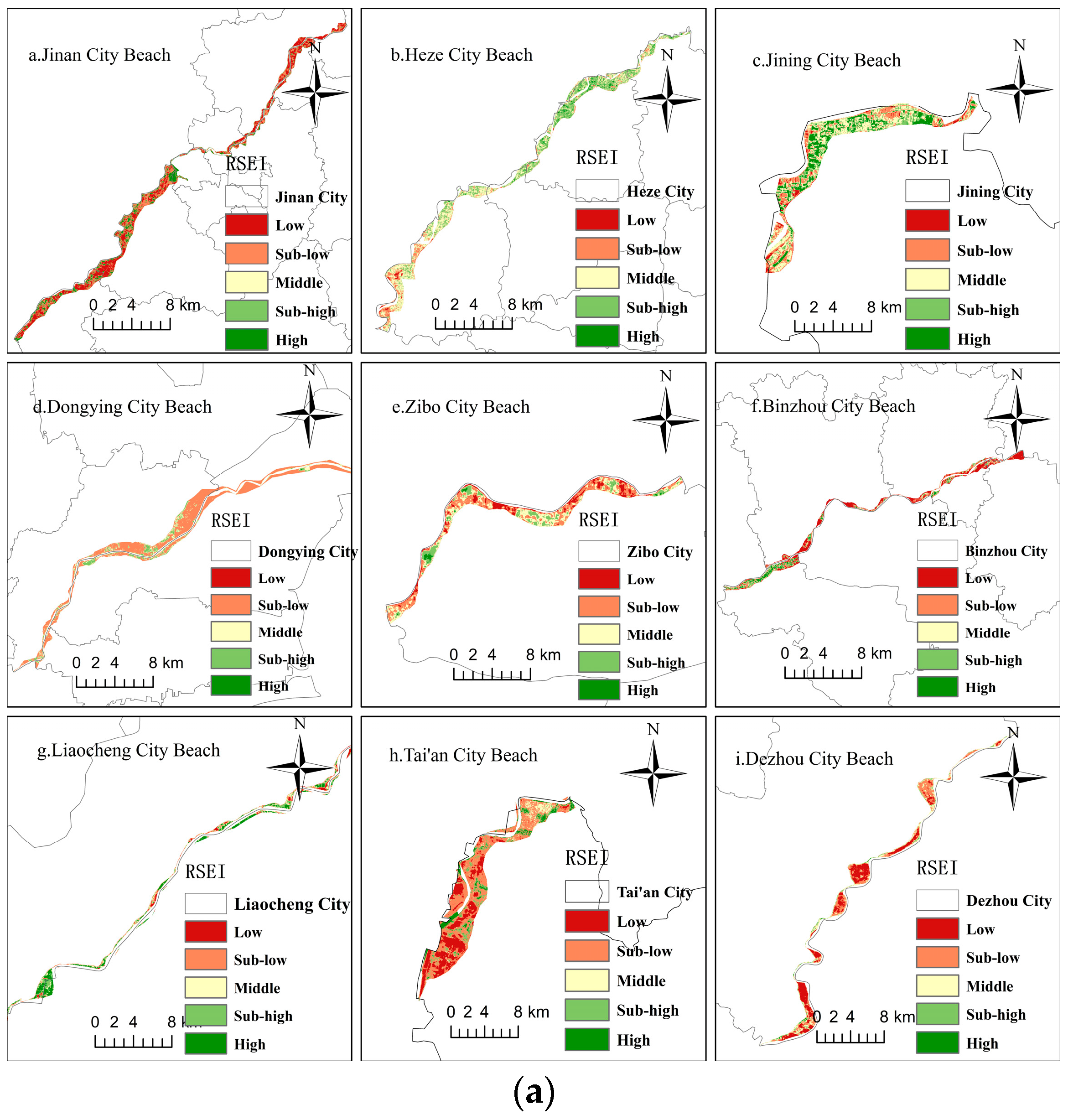
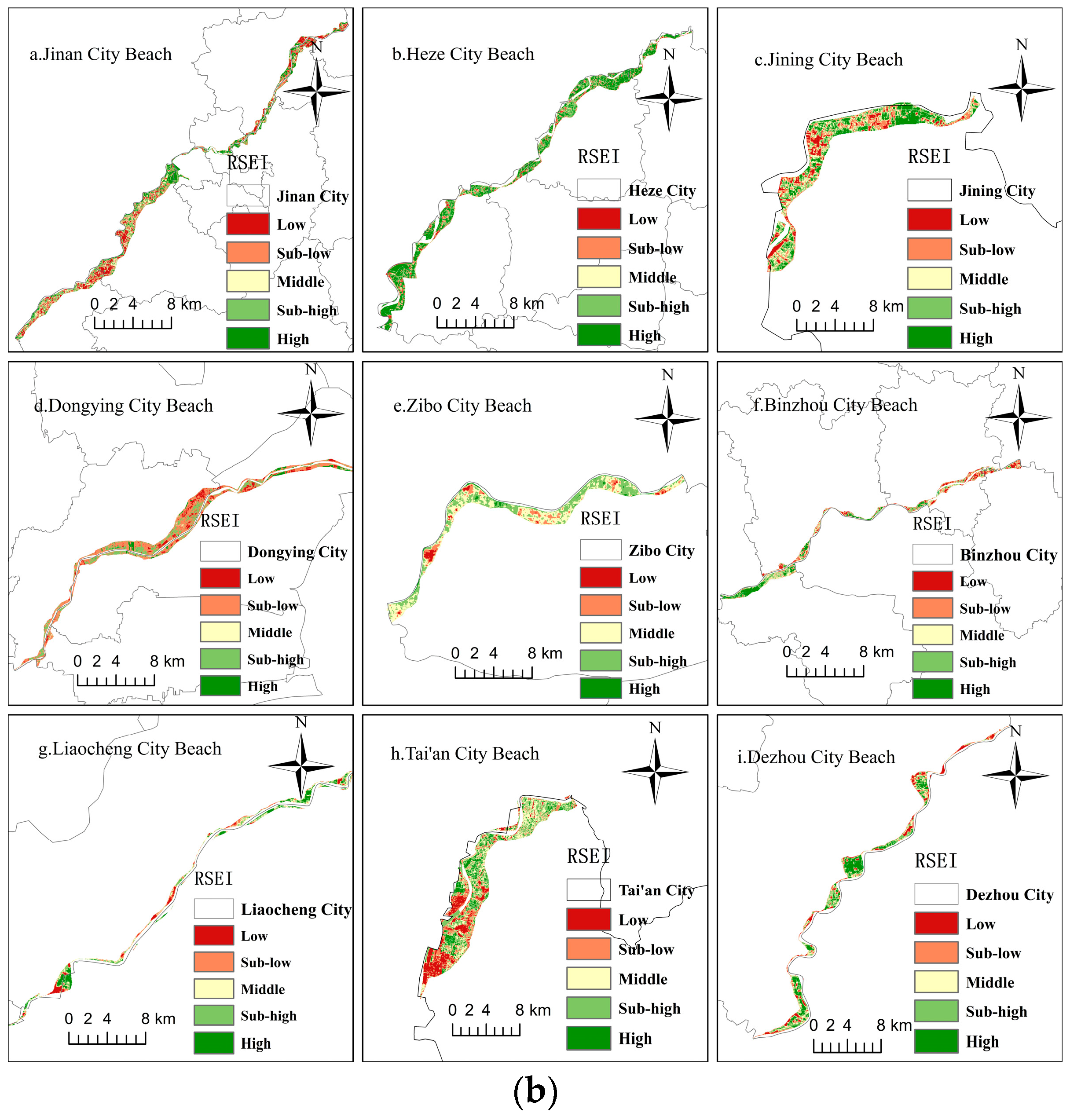

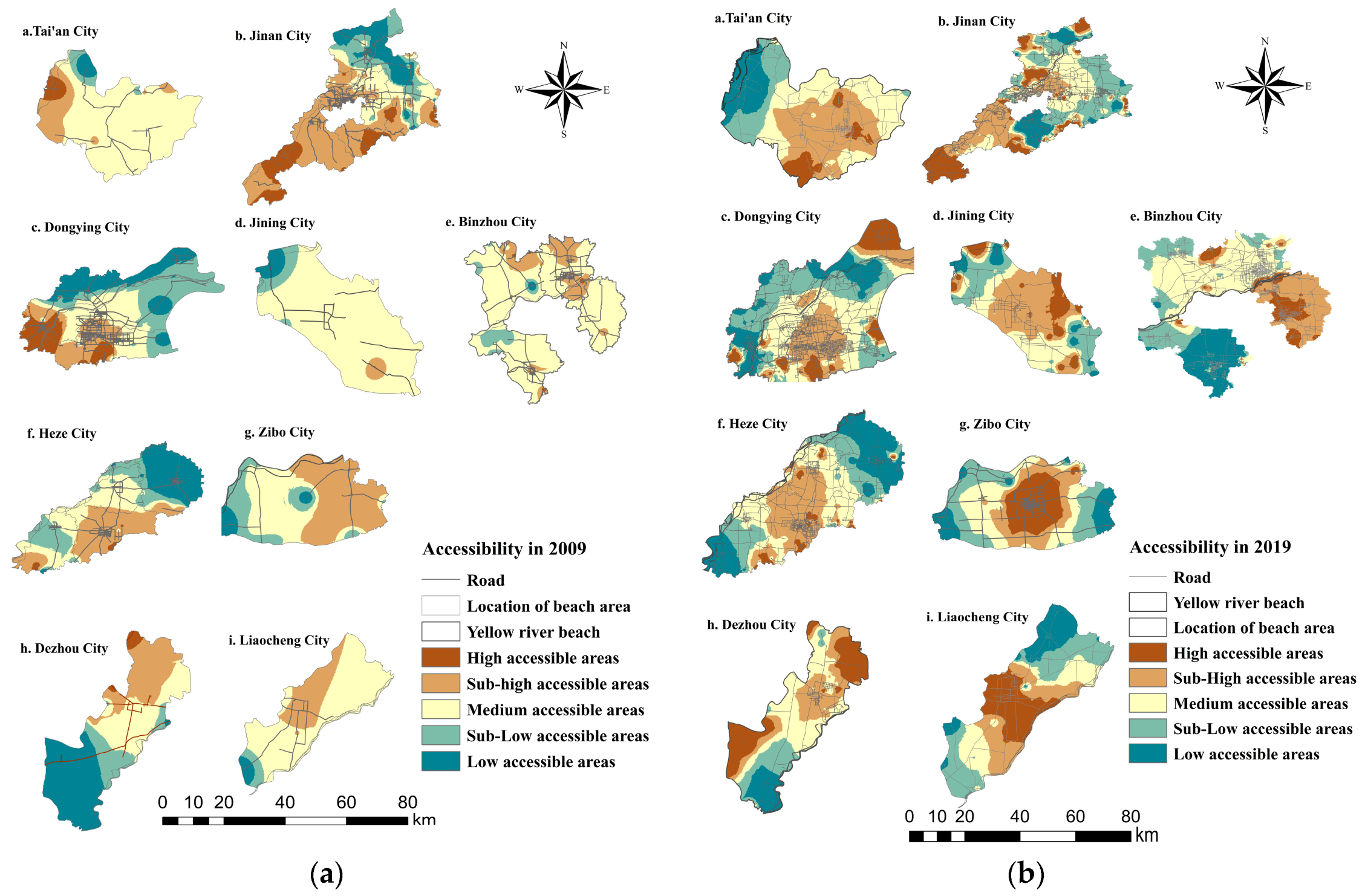

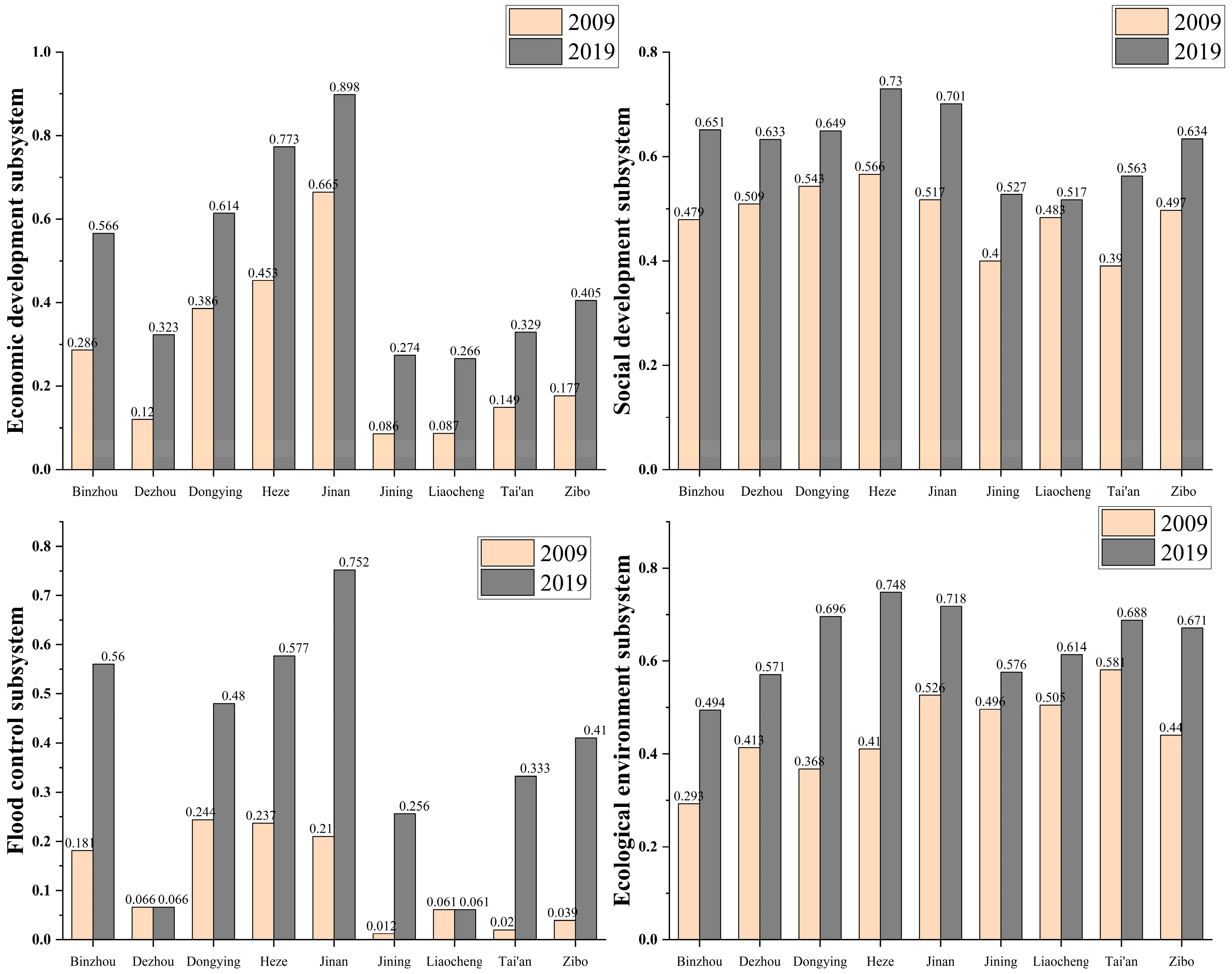


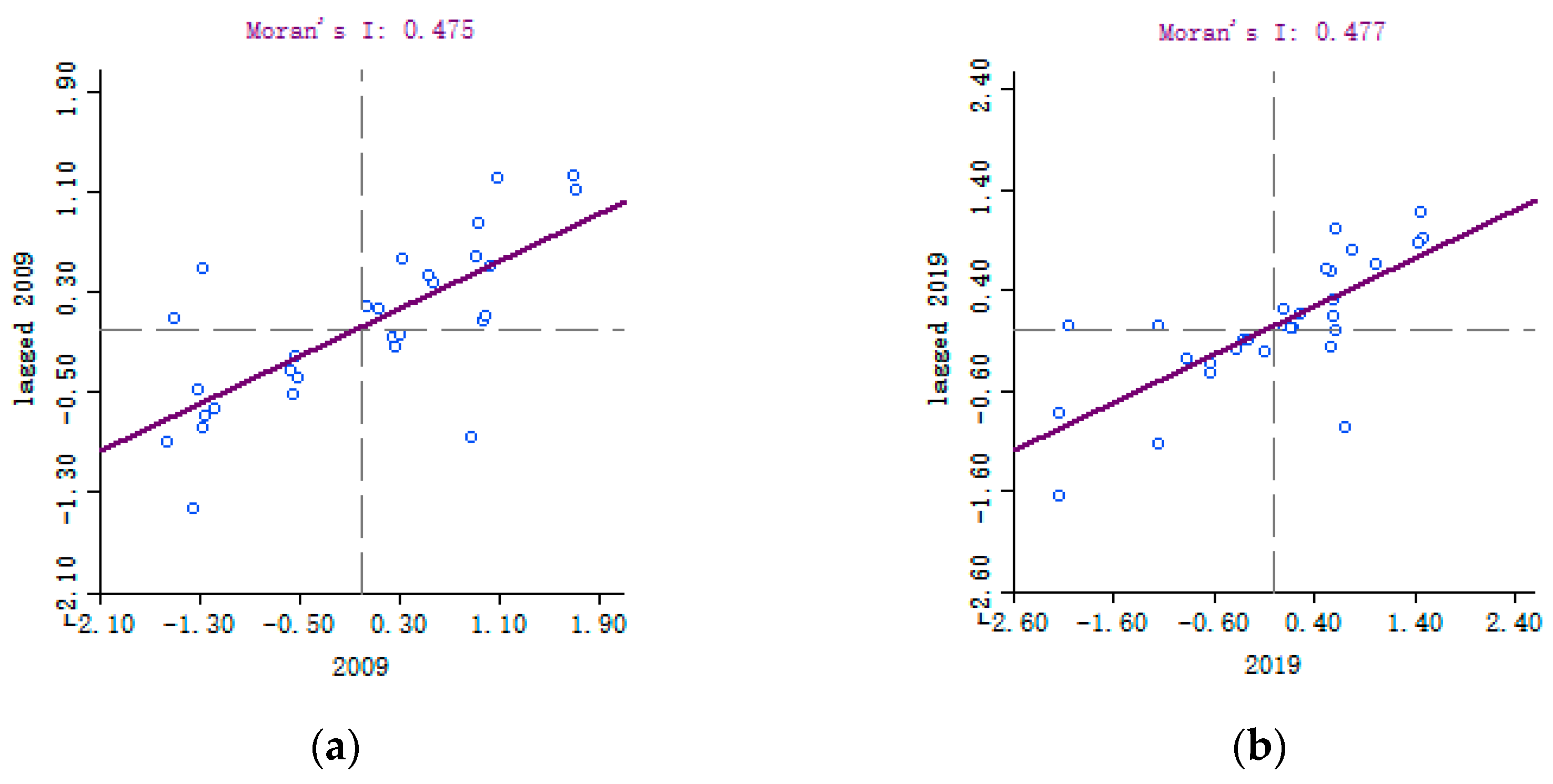

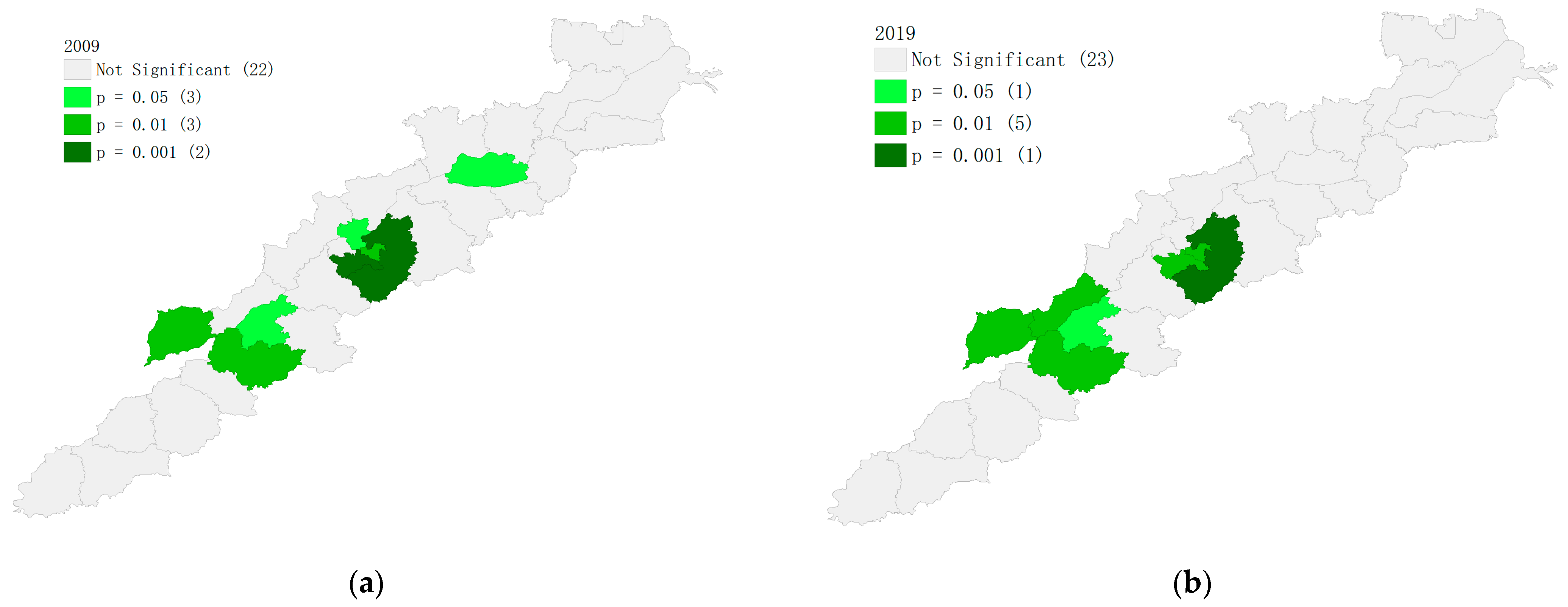
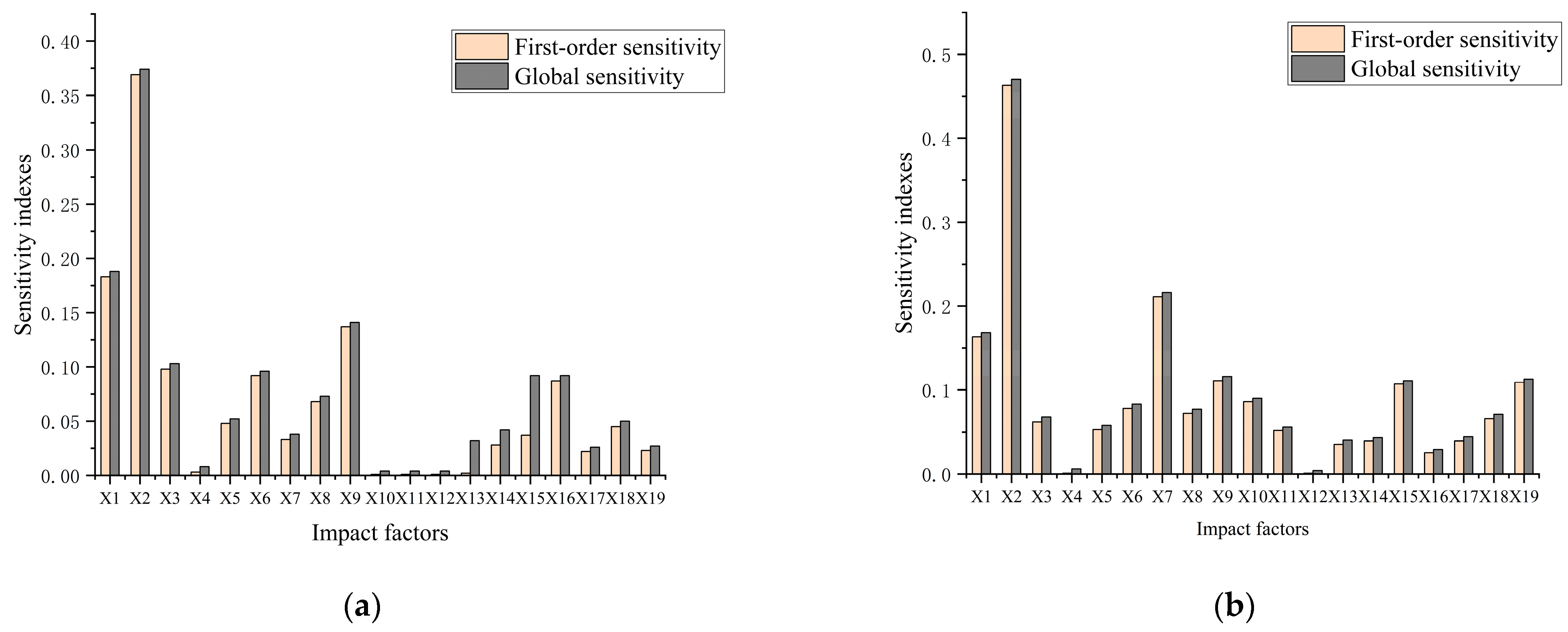

| Data Type | Data | Time | Data Format |
|---|---|---|---|
| Remote Sensing Image Map | Landsat5 TM | 2009 | Raster |
| Landsat8 OLI | 2019 | Raster | |
| Geospatial data | Land use data | 2009, 2019 | Raster |
| Precipitation data | 2009, 2019 | Raster | |
| CO2 Emissions | 2009, 2019 | Raster | |
| NDVI | 2009, 2019 | Raster | |
| GDP raster data | 2009, 2019 | Raster | |
| Population density data | 2009, 2019 | Raster | |
| Vector data | 2009, 2019 | Vector | |
| Social statistics | Shandong Provincial Statistical Yearbook | data | data |
| Statistical Yearbook for the 25 counties covered by the Yellow River Tract | data | data | |
| Statistical bulletin on the development of cities | data | data |
| Target Level | Guideline Level | Index Layer | Characteristic | CRITIC Weights | Entropy Method Weights | Combined Weights |
|---|---|---|---|---|---|---|
| High quality development | Level of economic development | Beach GDP (X1) | + | 0.0507 | 0.0724 | 0.0616 |
| Grain production (X2) | + | 0.0676 | 0.0603 | 0.0640 | ||
| Disposable income (X3) | + | 0.0589 | 0.0679 | 0.0634 | ||
| Social security | Employment rate (X4) | + | 0.0577 | 0.0683 | 0.0630 | |
| Population density (X5) | - | 0.0547 | 0.0563 | 0.0555 | ||
| Accessibility (X6) | + | 0.0441 | 0.0577 | 0.0509 | ||
| Level of poverty (X7) | - | 0.0541 | 0.0616 | 0.0579 | ||
| Education level (X8) | + | 0.0525 | 0.0626 | 0.0576 | ||
| Flood control construction | Rate of river and dam construction (X9) | + | 0.0376 | 0.0278 | 0.0327 | |
| Out-migration resettlement rate (X10) | + | 0.0498 | 0.0399 | 0.0449 | ||
| Local and local village platform rate (X11) | + | 0.0352 | 0.0278 | 0.0315 | ||
| Old Village Terrace renovation and upgrading rate (X12) | + | 0.0462 | 0.0406 | 0.0434 | ||
| Evacuation road construction rate (X13) | + | 0.0257 | 0.0210 | 0.0335 | ||
| Ecological protection | Ecological quality | Vegetation cover (X14) | + | 0.0543 | 0.0656 | 0.0600 |
| Flood risk intensity (X15) | - | 0.0731 | 0.0591 | 0.0661 | ||
| CO2 Emissions (X16) | - | 0.0747 | 0.0432 | 0.0590 | ||
| Beach area (X17) | - | 0.0393 | 0.0470 | 0.0432 | ||
| Index of biological abundance (X18) | + | 0.0546 | 0.0626 | 0.0586 | ||
| Ecological Condition Index (X19) | + | 0.0692 | 0.0583 | 0.0638 |
| Harmony Development Level Rating | EESF Value Range |
|---|---|
| No Harmony Level | 0 |
| Low Harmony Level | 2 |
| Sub-low Harmony Level | 4 |
| Medium Harmony Level | 6 |
| Sub-high level of harmony | 8 |
| High level of harmony | 1.0 |
| Ideal state | 1 |
| Coupling Coordination Level | Range of Coupling Coordination |
|---|---|
| Severe disorder stage | |
| Moderate disorder stage | |
| Approaching the disorder stage | |
| Basic coordination phase | |
| Moderate coordination phase | 0.8 |
| Highly coordinated phase | 1 |
| Region | 2009 Coordinated Coupling | 2019 Coordination Coupling | Degree of Annual Variation in Coupling Coordination |
|---|---|---|---|
| Shandong Province Yellow River Beach Area | 0.344 | 0.580 | 6.49% |
| Heze City | 0.454 | 0.736 | 6.22% |
| Jining City | 0.286 | 0.542 | 7.73% |
| Tai’an City | 0.252 | 0.511 | 10.32% |
| Liaocheng City | 0.272 | 0.403 | 4.82% |
| Dezhou City | 0.278 | 0.415 | 4.93% |
| Jinan City | 0.504 | 0.791 | 5.69% |
| Zibo City | 0.278 | 0.566 | 10.33% |
| Binzhou City | 0.348 | 0.608 | 7.46% |
| Dongying City | 0.426 | 0.646 | 5.16% |
| Parameter | 2009 | 2019 |
|---|---|---|
| Mean | 0.355 | 0.556 |
| Variance | 0.0012 | 0.0019 |
| Standard deviation | 0.034 | 0.044 |
| Coefficient of variation | 9.58% | 7.91% |
| Skewness | 0.078 | 0.049 |
| Kurtosis | −0.288 | −0.297 |
| Tchebycheff test | 0.0012 | 0.0013 |
| T test | 0.0004 | 0.0004 |
Disclaimer/Publisher’s Note: The statements, opinions and data contained in all publications are solely those of the individual author(s) and contributor(s) and not of MDPI and/or the editor(s). MDPI and/or the editor(s) disclaim responsibility for any injury to people or property resulting from any ideas, methods, instructions or products referred to in the content. |
© 2023 by the authors. Licensee MDPI, Basel, Switzerland. This article is an open access article distributed under the terms and conditions of the Creative Commons Attribution (CC BY) license (https://creativecommons.org/licenses/by/4.0/).
Share and Cite
Li, J.; Lu, Y.; Li, X.; Wang, R.; Sun, Y.; Liu, Y.; Yao, K. Evaluation and Analysis of Development Status of Yellow River Beach Area Based on Multi-Source Data and Coordination Degree Model. Sustainability 2023, 15, 6086. https://doi.org/10.3390/su15076086
Li J, Lu Y, Li X, Wang R, Sun Y, Liu Y, Yao K. Evaluation and Analysis of Development Status of Yellow River Beach Area Based on Multi-Source Data and Coordination Degree Model. Sustainability. 2023; 15(7):6086. https://doi.org/10.3390/su15076086
Chicago/Turabian StyleLi, Jing, Yuefeng Lu, Xiwen Li, Rui Wang, Ying Sun, Yanru Liu, and Kaizhong Yao. 2023. "Evaluation and Analysis of Development Status of Yellow River Beach Area Based on Multi-Source Data and Coordination Degree Model" Sustainability 15, no. 7: 6086. https://doi.org/10.3390/su15076086







